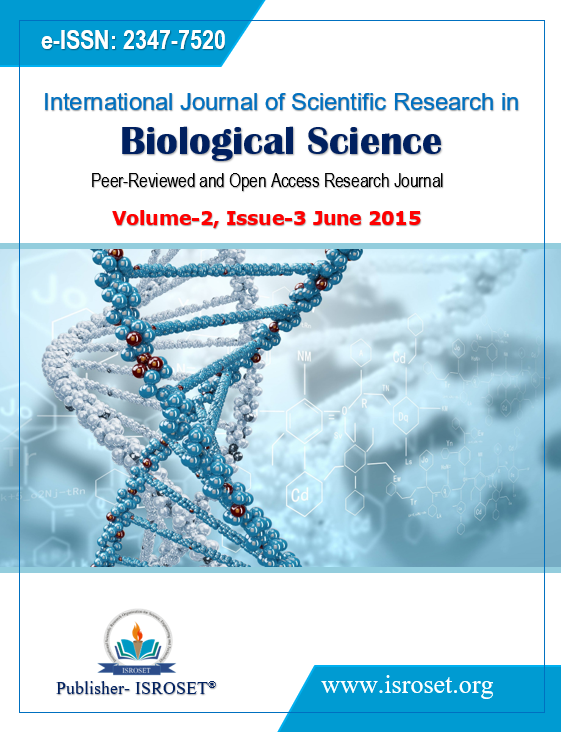Biomonitoring of Road Side Air Pollution Using Ascorbic ACID Content of Selected Trees at Ujjain
Keywords:
Air pollution, ascorbic acid, automobile exhaust, bio-indicators, de-toxicant, industries, tolerantAbstract
Air pollution is one of the severe problems facing the world today due to contineous changes in the environment resulting from human activities such as vehicular traffic and industries. Air pollution can directly affect plants via leaves or indirectly via soil acidification. Screening of plants for their sensitivity level to air pollutants is important because the sensitive plants can serve as bio-indicators and the tolerant plants as sink for controlling air pollution in urban and industrial areas. Ascorbic acid is a natural de-toxicant which may prevent the damaging effect of air pollutants in plant tissues. The level of this acid declines on pollutant exposure. The present study indicated that different road side trees responded differently against air pollution due to automobile exhaust. Ficus religiosa was found to be the most tolerant species while Santalum album and Aegle marmelose were found to be susceptible species.
References
Agrawal, S.B. Singh A., Rathore D. (2004). Interactive effect of air pollution and nutrients on biochemical processes and yield of wheat grown in peri-urban areas of Allahabad city. Ecoprint 11: 1-6.
Deepalakshmi, A.P., Ramakrishnaiah H., Ramchandra Y.L., and Radhika R.N. (2013). Road side plants as Bio-indicators of urban air pollution. IOSR of Environmental science, toxicology and food technology (IOSR-JESTFT) e-ISSR: 2319-2402, p- ISSN: 2319-2399. Volume 3, PP 10-14.
Chauhan A. Joshi P.C. (2008). Effect of ambient air pollution on photosynthetic pigments on some selected trees in urban area. Ecology, Environment and Conservations. 14 (4): 23-27.
Cheng,F. Y., K. O. Burkey, J. M Robinson, (2007). Leaf extracellular Ascorbic in relation to O3 tolerance of to soyabean cultivars, Environ Pollut. (150), 355 -362.
Dwivedi A.K., Tripathi B.D. (2007). Pollution tolerance and distribution pattern of plants in surrounding area of coal-fired industries, J. Environ. Biol. 28(2): 257-263.
Escobedo,F.J.Wagner,et.al., (2008). Analyzing the cost effectiveness of Santiago, Chile’s policy of using urban forest to improve air quality, J. of Environmental Management. 86:148-157.
Gilbert O.L., (1968). Biological indicators of air pollution. University of New caslte upon Tyne, Great Britain.
Hoque MA, Banu MNA, Okuma E. (2007). Exogenous proline and glycinebetaine increase Naclinduced ascorbate-glutathione cycle enzymes activities, and Praline improves salt tolerance more than glycinebetaine in tobacco bright yellow-2 suspension cultured cells, journal plant physiol.Vol. 164, PP. 1457-1468.
Jain A. and Kutty, S. (2014). Biomonitoring of dust pollution of road side of Harda using Air Pollution Tolerence Index (APTI).
Joshi,P.C. and A.Swami (2007). Physiological responses of some tree species under roadside automobile pollution stress around city of Haridwar, India, Environmentalist, Vol.27, PP.365-374.
Joshi,P.C.Swami, A. (2009). Air pollution induced changes in the photosynthetic pigment of selected plant species. J. Environ. Biol. 30:295-298.
J.S. Jyothi, and Jaya, (2010), Evaluation of air pollution tolerance index of selected plant species along roadsides in Thiruvananthapuram, Kerala. Journal of Environmental Biology, 31, 379-386.
Margeson, J. H. (1977). Evaluation of the sodium Arsenite method for measurement of NO2 in ambient air. Journal of the Air Pollution Control Association. 27: 553-556.
Prajapati. S.K. and B.D.Tripathi. (2008). Seasonal variation of leaf dist accumulation and pigment content in plant species exposed to urban particulates pollution. J.Env.Quality.37: 865-870.
Thimmaiah S.R., (1999). Standard method of biochemical analysis. Mrs. Usha Raj Kumar for Kalyani Publishers, New Delhi- 100 02, 278-279.
Tripathi A. K. Gautam M. (2007). Biochemical Parameters of plants as indicators of air pollution. J. Evn. Biol.28 (1): 127-32.
Downloads
Published
How to Cite
Issue
Section
License

This work is licensed under a Creative Commons Attribution 4.0 International License.
Authors contributing to this journal agree to publish their articles under the Creative Commons Attribution 4.0 International License, allowing third parties to share their work (copy, distribute, transmit) and to adapt it, under the condition that the authors are given credit and that in the event of reuse or distribution, the terms of this license are made clear.







